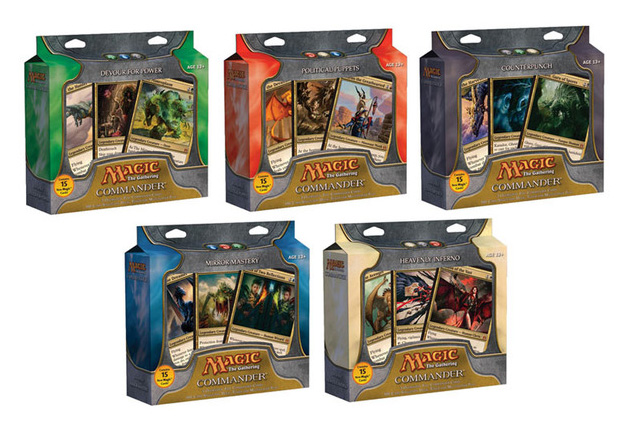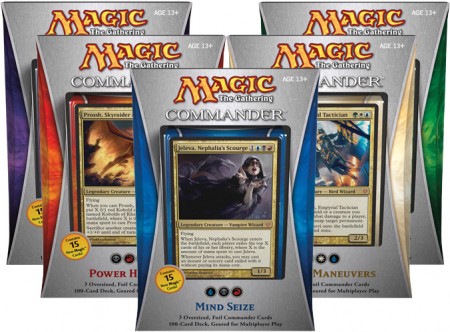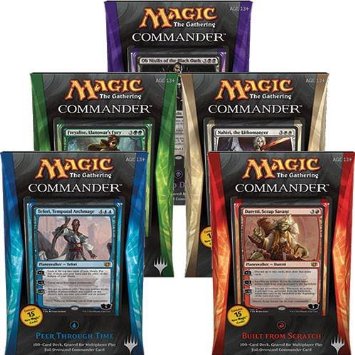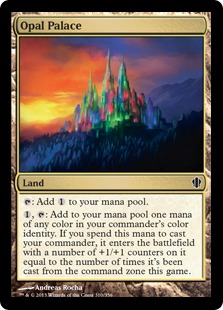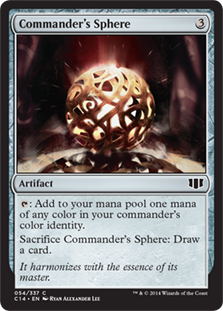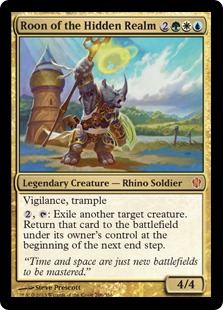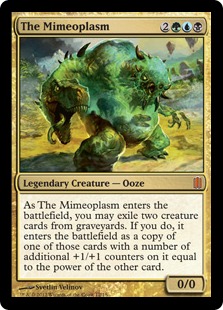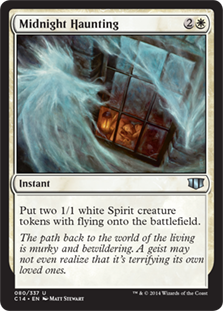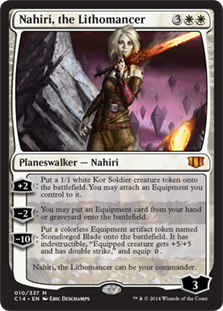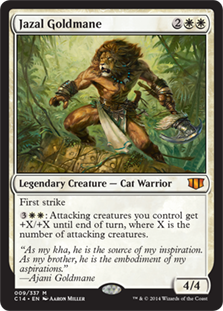Welcome back to Magic Gatherings! Last week we spent some time looking at budget hits from Fate Reforged—cards that will play well in your commander decks, which you probably can find lying around abandoned after draft night at your friendly local gaming store. I left one major thing unmentioned, however, as one astute commentator pointed out: preconstructed decks.
For those who aren’t aware, “precons” are decks that Wizards sells pre-built and ready to play, right out of the box. You can find them at your local gaming store, and usually near the checkout aisles at Target and Wal-Mart. Each copy of a precon has exactly the same cards, and you can find the decklists online. There are actually several different series: Intro Packs, Duel Decks, Clash Packs, and Event Decks. But for this series, we’re especially interested in preconstructed Commander decks.
Wizards debuted their first series of Commander precons in 2011. This first foray had five decks, each designed around a different “wedge” of one color with its two enemies. (We know them now by their clan names, as the wedges have recently gotten more love in the Khans of Tarkir expansion.) These were popular decks, not least because they introduced a number of new legendary commanders and new cards for color combinations which previously had little support. Today these are very hard to find and sell for two or three times their sticker price on eBay—if you’re lucky.
Based on the success of those decks, WotC created another series for 2013. This time, the decks focused on the five “arcs” or “shards”—each color with its two allies.
At this point, Commander was designated as an annual product. The 2014 decks came out last November: again, five decks, this time one for each color. These decks each featured a planeswalker who could be your Commander.
While we don’t know any details about the 2015 decks at this point, we know they’re coming this fall.
For a lot of reasons, precons are a great starting point for players who are new to Magic or interested in bringing it to their friends. However, they’re not the be-all, end-all. I started writing down my thoughts, and it turned out I had plenty to say. So, for this week: all about precons!
PROS
Precons do a lot of things right, which make them a valuable resource. Here are several worth highlighting.
Playable out of the box: This is so obvious that it might be overlooked, but it’s worth mentioning: WotC has done all the work for you with these decks. You can open them up, shuffle them, and have a great game with no more effort required on your part. (I guess they won’t tap the cards for you. I’m sure they’re working on that, though.)
If you’re brand new to the game and aren’t familiar with thousands of past cards, or if you’re a busy professional, you could do way worse than picking up a few precons and offering them to your friends.
Pre-Balanced: The decks in each series are built to be relatively well balanced against each other, which also lends them to being a reasonable out-of-the-box play experience. One deck has to be the best, and another has to be the worst, of course—but generally speaking each one can win a game and everyone will feel they have a chance to play.
Good Value: Assuming you wanted to buy each of a precon’s cards individually, you’d spend a good bit more than the MSRP for the deck, which runs between $30 and $35—sometimes less, if you get all five decks in a set all at once. They’re not cheap, but if you don’t own many of the cards in the deck already, you certainly get your money’s worth. Occasionally a single card in the deck is worth a fair percentage of the deck’s total value, and you can sell or trade that to recoup even more of the cost.
They’re also great places to acquire format staples—cards which tend to show up in lots of Commander decks because they’re powerful and resilient, and which therefore can have a high price. [mtg_card]Wurmcoil Engine[/mtg_card], out of C14’s “Built From Scratch” deck, is a great example ($12 on Star City Games, as of this writing).
Each deck also reprints a legendary creature which has been a popular Commander in the past: [mtg_card]Rubinia Soulsinger[/mtg_card], [mtg_card]Thraximundar[/mtg_card], and [mtg_card]Sharuum the Hegemon[/mtg_card], for example. Should you ever decide to take apart a precon, many of its cards will find good homes in other decks.
Unique and Powerful cards: Beyond staples, each preconstructed deck contains a number of new cards. Many of these cards are geared specifically for multiplayer formats—either they are undercosted for the effect they provide, or they’re designed to engage several opponents at once, or they force you to negotiate with the other players.
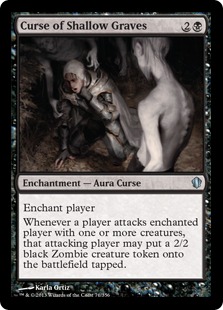

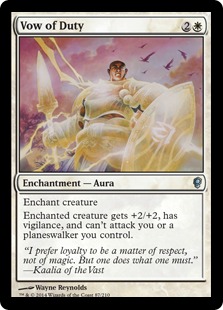
Cards in normal Magic expansions aren’t always geared for multiplayer games. WotC is becoming more mindful of this (look for phrases like “each opponent” in the card text), but the fact is that the core game is designed for 1v1 play. It’s nice to have cards intended specifically for multiplayer games—Commander games in particular.
Plus, new Commanders! So far each precon has featured two brand-new legendary creatures (and/or planeswalkers) who could headline your deck. Some of these creatures support strategies in ways no other existing card does, which means they inspire unique decks that you might want to build.
A good starting point for growing a deck: And that’s another point! No one says you have to keep these decks unaltered in their preconstructed form. As you acquire more cards (by opening boosters, maybe, or buying more precons), you can add new favorites and take out cards you don’t like as much. In fact, there are usually a few clear clunkers to upgrade, so that you get some experience tuning decks.
Even better, most precons give you multiple directions to develop the deck, by presenting two or more strategies to focus on. You can pick the one you like best keep the cards which support it, cut the others, and add some new stuff in to fill it out. If you want a hint, check out the legendary creatures in each deck: usually, one supports one strategy, the other supports the other.
For example, in the “Forged in Stone” deck, Nahiri is clearly your “equipment” commander, while Jazal wants you to make tons of tokens and attack with lots of creatures at once. When I upgraded my copy of the deck, I focused on the equipment theme, adding a few cards I had which played well with that, and removing some of the cards dedicated to making creature tokens, like Midnight Haunting or Spectral Procession.
Here’s a quick crib sheet, in case you’re already thinking of grabbing some precons and want to pick your favorite themes:
Commander 2013
- Eternal Bargain (White, Blue, Black): Lifegain, artifacts
- Nature of the Beast (White, Green, Red): Beast creatures, creatures with 5+ power
- Power Hungry (Green, Red, Black): Creature tokens, sacrificing things
- Mind Seize (Blue, Black, Red): Big spells, drawing cards (and punishing your opponents for drawing)
- Evasive Maneuvers (Green, White, Blue): Tapping and untapping, “blinking” (briefly removing creatures with enters-the-battlefield triggers from play, then returning them, so you get the trigger again)
Commander 2014
- Forged in Stone (White): Equipment, creature tokens
- Peer Through Time (Blue): Creatures with morph; huge krakens, leviathans, and octopi
- Sworn to Darkness (Black): Zombie creatures; demons; killing all creatures in play
- Built from Scratch (Red): Artifacts, especially sacrificing them and getting them back from the graveyard
- Guided by Nature (Green): Elf creatures, lands
CONS
So that all sounds pretty sweet, right? It’s true that precons have a lot of stuff going for them. That said, they have some drawbacks you should be aware of:
Some weak cards: This is, in part, a side effect of the fact that precons are designed to starting points which players build on: there are some weak cards which are meant to be identified as underperformers and subsequently upgraded. Of course, if you never actually do upgrade the cards (or worse, don’t realize that that’s what the cards are in the decks for), your deck will always have some clunkers in it.
Losing a game because your opponents drew effective, interactive cards is one thing—that’s a good multiplayer experience. Losing because you drew the worst card in your deck, and it was awful? No so much.
Not Personalized: This won’t affect all players equally, but I find that one of the most rewarding parts of playing Commander is designing a deck around a creature myself. I’m especially proud when I find an obscure card that just works perfectly with what the deck is trying to do. I try to make decks that really suit the commander, not mere collections of good cards in a particular color combination.
More broadly, some people just don’t like the feeling that the deck has been built for them. Part of what’s fun about Magic is deckbuilding and customization, and taking that part of the game away is a big negative for some.
Unexpected secondary market value: Remember that I mentioned those specially designed, just-for-Commander utility cards? Well, it turns out that those are legal for play in a few tournament formats, where their low mana costs can make them very attractive cards. The most infamous offenders are surely [mtg_card]Baleful Strix[/mtg_card] and [mtg_card]True-Name Nemesis[/mtg_card], which both appeared in the Commander 2013 “Mind Seize” deck. That was enough to drive its price to almost double the printed MSRP in some places.
This hasn’t been as much of a problem with the Commander 2014 decks: there was speculation that [mtg_card]Dualcaster Mage[/mtg_card] and [mtg_card]Containment Priest[/mtg_card] would spike prices of the red and white decks, respectively, but that never really materialized. Wizards has shown that they are willing to produce extra print runs if demand for Commander products warrants it. That will hopefully prevent other Commander series from being like the 2011 decks—products people squirrel away to flip on eBay years later.
Divided strategies: As we mentioned above, most precons promote at least two distinct strategies. That can be a benefit, if you’re looking for inspiration for your next deck, and a big jump start on the cards for it. On the other hand, it means that when played out of the box, you can get draws that are awkward, or completely nonfunctional.
Take this hand from the “Forged in Stone” deck: [mtg_card]Spectral Procession[/mtg_card], [mtg_card]Whitemane Lion[/mtg_card], [mtg_card]Twilight Shepherd[/mtg_card], [mtg_card]Moonsilver Spear[/mtg_card], [mtg_card]Plains[/mtg_card], [mtg_card]Plains[/mtg_card], [mtg_card]Gift of Estates[/mtg_card].
Your tokens don’t really work with [mtg_card]Whitemane Lion[/mtg_card] or [mtg_card]Twilight Shepherd[/mtg_card], since tokens disappear when they hit the graveyard or go to your hand. You can equip [mtg_card]Moonsilver Spear[/mtg_card] to the Spirits, but Nahiri could do that for you anyway, and the Spear doesn’t make them more dangerous to your opponents. It’s easy to imagine drawing Jazal to tie the room together here, but equally easy to imagine an opponent casting [mtg_card]Naturalize[/mtg_card] on your spear and leaving you with a bunch of tokens.
Great Commander decks aren’t strictly monotone. But they also have a little more redundancy and are a little more streamlined than what you get from precons.
Slow Games: This is the biggest issue with snagging a set of precons and rolling them out for your friends. As I said above, the decks tend to be relatively balanced on power level, but that power level is also relatively low. That’s not to say the decks don’t have good individual cards, nor that they can’t produce powerful plays. But they tend to lack true haymakers, as well as the raw card-drawing power which is usually necessary to create an advantage which puts one deck ahead for good.
As a result, games can grind to a stall where each player is drawing one card per turn, and those cards are relatively balanced, and no single player can actually attack profitably, take control of the game, or win. My group and I had a game with the 2014 precons (five players, one of each color, win by eliminating your two enemy colors) go on for over three hours.
This is less of an issue with the 2013 precons, since that set had cards like [mtg_card]Gahiji, Honored One[/mtg_card] and [mtg_card]Nekusar, the Mindrazer[/mtg_card]—cards that encourage attacking, or drive the game toward a natural conclusion by dealing damage to everyone. If you play with the 2014 precons, though, I strongly recommend adding a few powerful cards, or using a meta-rule to keep the game moving.
—
All in all, precons are great tools, especially for newer players. They are unparalleled in their ease and convenience and offer a quick way to get Commander into your game nights that won’t cost a fortune in money or time. They’re also a great place to get started with identifying strategies, evaluating cards, and modifying decks. You can buy a few and play real games with them, and slowly grow them as you become more comfortable.
They have some drawbacks, yes, but the net positives outweigh them, I think. And, as we’ve seen, some of the “cons” are inseparable from the “pros”—you can’t make your preconstructed decks a good tool for beginning deckbuilders if you don’t include a few suboptimal cards, for example, and you can’t pack multiple cool strategies into a single deck without the possibility that you’ll draw the wrong mix of cards.
One last word on other preconstructed products, like Clash Packs and Duel Decks: these tend to be designed and marketed for 1v1 play. With Clash Packs and Duel Decks, the decks included are specifically designed to be played against each other—each has strengths and weaknesses that are especially well suited to the companion deck. They make for a very fun duel, but they’re usually not ideal for multiplayer games.
However, like Commander precons, they tend to be excellent values, and each has a number of flexible, powerful cards which could easily be included in a Commander deck. Don’t be afraid to pick one up—they’re fun to jam against each other, and they give you options for upgrading decks in the future.
That’s all we’ve got for this week! I’d love to hear your feedback in the comments. Did I miss any of your favorite points or pet peeves about precons?

